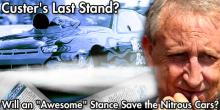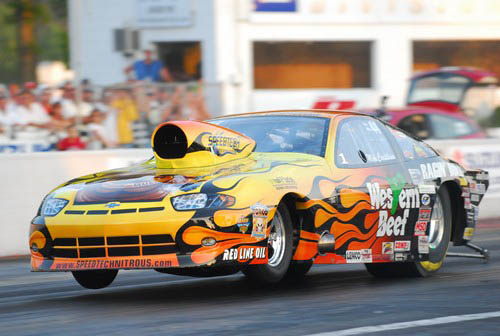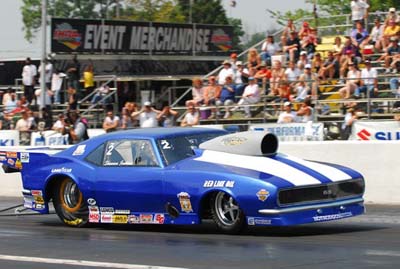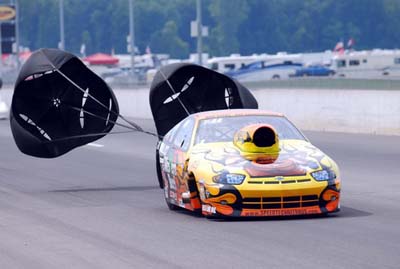THEY’RE NOTHING SHORT OF AWESOME
Mon, 2006-11-06 13:02
 At first glance they may seem an unlikely duo; Mike Castellana, with
his clipped New York accent, and Shannon “Iceman” Jenkins and his cool
Alabama drawl. But, since 2001, when the pair pooled their resources to
become Awesome Motorsports, they have become the most formidable
nitrous team since the inception of Pro Modified.
At first glance they may seem an unlikely duo; Mike Castellana, with
his clipped New York accent, and Shannon “Iceman” Jenkins and his cool
Alabama drawl. But, since 2001, when the pair pooled their resources to
become Awesome Motorsports, they have become the most formidable
nitrous team since the inception of Pro Modified. Last season was arguably their best as Castellana claimed the 2005 Torco Racing Fuels Pro Modified championship and Jenkins finished in second place. “It wasn’t because of an E.T. advantage,” explained Jenkins, the architect of their ascendancy. “It was just a solid year of good racing. We were never the Number 1 qualifier. We qualified well, but as these new blown teams develop, (they have) really accelerated this year.”
Mike Castellana and Shannon Jenkins Are Proving That Nitrous-Powered Pro Mods Can Still Win

At first glance they may seem an unlikely duo; Mike Castellana, with his clipped New York accent, and Shannon “Iceman” Jenkins and his cool Alabama drawl. But, since 2001, when the pair pooled their resources to become Awesome Motorsports, they have become the most formidable nitrous team since the inception of Pro Modified.

The blower (technology) got super out of control compared to what they had in 2002. - Shannon Jenkins
Once the province of nitrous oxide technology, Pro Modified saw supercharged cars dominate the 2006 season, which the pair argues is due in part to IHRA rule changes originally instituted to give parity. “There weren’t many blown cars qualifying (around 1997-98),” recalled Castellana, “except for Scotty Cannon, and he was always at the top of the pack. If he could do it, I’m sure other guys should have been able to. But, they changed the rules and it just escalated from there.”
“The blower (technology) got super out of control compared to what they had in 2002,” said Jenkins, referring to the season his nationally recognized blue ’69 Camaro dominated both the IHRA and the new NHRA exhibition Pro Mod class. “They also didn’t allow the hemi-head back then. All those things make significant horsepower, and it takes a little while to get all that stuff dialed in. Guess what--now they’re all dialed in and a nitrous car has a serious dilemma. You have talented individuals like Al Billes tuning five of the top front-running blower cars; you’ve got Carl Spiering, who tunes his own and Alan Pittman’s car; Mike Janis, who runs well on his own; Howard Moon with (Josh) Hernandez and (Troy) Critchley [Hernandez having recently broken the 5-second barrier]--super good tuners, you can’t take it away from these guys.”
In spite of this turn of events, Jenkins and Castellana remain fiercely loyal to the laughing gas. “I’ve never even considered switching to a supercharger, ever,” Jenkins said. “If we had to switch to a blower motor tomorrow, we’d be out of Pro Mod.”
Jenkins’ spectacular career in Pro Modified began when he served as Norman Estes’s crew chief in 1990. In 1995 he helped Tommy Mauney and his Willys win the IHRA championship. At the end of that season the Parsons Bros. bought out Mauney and hired Jenkins as a driver/tuner. They went on to win the IHRA Pro Mod championship in 1997 and ’99. By 2000 Jenkins’ expertise was such that he was leasing out motors to clients like Castellana. The latter was so impressed he promptly proposed a partnership. In 2003 they solidified their alliance by opening Speedtech Nitrous Systems, a high-end speed shop in Tuscaloosa, AL. “Pro Mod isn’t even the tip of (our) iceberg,” says Jenkins. “We’ve got every major nitrous engine builder in the country using our products.”
a d v e r t i s e m e n t
Click to visit our sponsor's website

With nitrous, there's not many people doing it. You don't have a fall back class like you do with the blower cars. You don't have what I call a trickle-down effect -- performance coming down from the other classes. - Mike Castellana
Getting everything they need has proven to be a tall order, however, as the Awesome Motorsports team recently discovered. In September the team announced that it was going to use Pro Stock bodies for the 2007 season -- a GTO for Jenkins, a Mustang for Castellana. The IHRA subsequently made a rule adjustment banning Pro Stock-legal bodies beginning with the 2008 season. “Aerodynamically the (next) closest thing would be the ’63 Corvette,” Castellana explained. “We didn’t like it because there’s too many of them, but we didn’t have much choice.”
Then they learned of a loophole in the IHRA rule, or at least they thought they had. The Toyota Solara body style wasn’t considered legal for Pro Stock since it wasn’t domestic, thus theoretically it could be used as a Pro Mod car. But then the IHRA closed that loophole, leaving the duo very frustrated. Now they’re back to “Plan A,” building the late-model GTO and Mustang solely for the 2007 season. “After that, who knows?” said Castellana, “Sometime in the middle of (next year) we’ll have to decide which direction we’re going to head.”
Besides the new body styles, Jenkins and Castellana are relying on IHRA Tech Director Mike Baker and the tech guys to make an adjustment where the blower cars are concerned. “I’m assuming they will,” said Jenkins. “If they don’t, there are only three or four teams at best that will compete with a nitrous program. The horsepower numbers are not even in the same ballgame. We’re constantly working on our motors, on our nitrous program. We’ve got motors on the dyno as we speak. We’ve got a lot of things we’re trying to achieve for next year. The Castellana-Jenkins team is definitely not quitting if they’ll put in a threshold and stop these (blower) guys where they’re at.”
a d v e r t i s e m e n t
| {flashembed}swf=/images/banners/flashBanner/ramad1.swf|w=468|h=60{/flashembed} |
Click to visit our sponsor's website
 In the search for better numbers, Jenkins has even had to leave Gene Fulton, his long-time engine builder, for Reher-Morrison. “Me and Gene have been together for a lot of years with no conflict whatsoever,” explained Jenkins, “and I’m sure he probably hates me leaving. I hate leaving. I’m looking for that extra something that I don’t have. So what do you do? You’ve got to go out and research and find the people you think might get you that extra something.”
In the search for better numbers, Jenkins has even had to leave Gene Fulton, his long-time engine builder, for Reher-Morrison. “Me and Gene have been together for a lot of years with no conflict whatsoever,” explained Jenkins, “and I’m sure he probably hates me leaving. I hate leaving. I’m looking for that extra something that I don’t have. So what do you do? You’ve got to go out and research and find the people you think might get you that extra something.”“With nitrous, there’s not many people doing it,” Castellana pointed out. “You don’t have a fall-back class like you do with the blower cars. You don’t have what I call the trickle-down effect -- performance coming down from other classes. We run three stages of nitrous. There’s a lot of misconception (with) people thinking we can just add another stage. Believe me, if that were true, we would have done it a long time ago. There’s only so much nitrous you can stuff into the motor regardless if you put it in with one stage or five stages.”
Given the choice, what would Jenkins like to see the IHRA do? “I’d like to see them adjust the blower a little bit,” he replied. “I’m not talking about choking them, I’m just talking about some type of adjustment that would take seven or eight hundredths of a second out of them. You can’t take any more weight off the nitrous cars. We’ve got the highest-priced race cars in the world in a Pro Mod version. It weighs 2485 lbs. With every trick you can put in, you cannot get a nitrous car lighter with a 200 lb. driver.
a d v e r t i s e m e n t
| {flashembed}swf=/images/banners/flashBanner/reherad2.swf|w=468|h=60{/flashembed} |
Click to visit our sponsor's website
 “If the IHRA doesn’t want a nitrous car and we’re not competitive,” Jenkins continued, “we’ll make a decision at that point. Right now we’re still willing to do the research and development. I don’t care about the NHRA, we don’t run that anymore, for the same reason--we definitely weren’t competitive over there. We do run the ADRL, a super place to go race, with nitrous vs. nitrous, blown vs. blown. You watch next year what they do, because all of the nitrous cars are going to run.”
“If the IHRA doesn’t want a nitrous car and we’re not competitive,” Jenkins continued, “we’ll make a decision at that point. Right now we’re still willing to do the research and development. I don’t care about the NHRA, we don’t run that anymore, for the same reason--we definitely weren’t competitive over there. We do run the ADRL, a super place to go race, with nitrous vs. nitrous, blown vs. blown. You watch next year what they do, because all of the nitrous cars are going to run.”“My opinion is if it becomes an all-blower class,” said Castellana, “then eventually it’ll become an Alcohol Funny Car class, because the faster these cars go, the more safety rules will have to be implemented, and before you know it, it will be another Funny Car class. And, if you look around at the Alcohol Funny Car class in NHRA and IHRA, it’s not doing very well. I always look to Shannon to set the standards for nitrous, and I think he’ll still continue to do so, and I think (the other nitrous teams) will be looking to see if we can make it competitive, (because) we’re doing everything we can.”
In some respects the future of nitrous oxide-powered race cars rests on the shoulders of Jenkins and Castellana. If those shoulders are broad enough – and thus far they appear to be – Pro Modified as we’ve come to know it, with its mixture of blown and nitrous-equipped cars, will continue to be a headline-grabbing attraction.
| {loadposition feedback} |
Categories:



